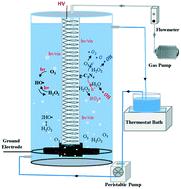当前位置:
X-MOL 学术
›
Environ. Sci.: Water Res. Technol.
›
论文详情
Our official English website, www.x-mol.net, welcomes your
feedback! (Note: you will need to create a separate account there.)
Degradation of pharmaceutical contaminants by bubbling gas phase surface discharge plasma combined with g-C3N4 photocatalysis
Environmental Science: Water Research & Technology ( IF 3.5 ) Pub Date : 2021-1-20 , DOI: 10.1039/d0ew00985g Xiaoping Wang 1, 2, 3, 4, 5 , Jihang Luo 1, 2, 3, 4, 5 , Yunzhu Huang 1, 2, 3, 4, 5 , Jie Mei 1, 2, 3, 4, 5 , Yixia Chen 1, 2, 3, 4, 5
Environmental Science: Water Research & Technology ( IF 3.5 ) Pub Date : 2021-1-20 , DOI: 10.1039/d0ew00985g Xiaoping Wang 1, 2, 3, 4, 5 , Jihang Luo 1, 2, 3, 4, 5 , Yunzhu Huang 1, 2, 3, 4, 5 , Jie Mei 1, 2, 3, 4, 5 , Yixia Chen 1, 2, 3, 4, 5
Affiliation

|
The feasibility of using gas phase surface discharge with microporous bubbling for the degradation of pharmaceutical contaminants was evaluated. After 25 min of treatment, 82% removal of ibuprofen (with an initial concentration of 60 mg L−1) and 100% removal of tetracycline hydrochloride (with an initial concentration of 200 mg L−1) was achieved. To utilize the UV and visible radiation produced in the discharge process, a g-C3N4 photocatalyst was added into the solution to enhance the degradation efficiency. Adding 75 mg L−1 g-C3N4 can increase the removal of ibuprofen by 18% (initial concentration of 10 mg L−1) and tetracycline hydrochloride by 10% (initial concentration of 100 mg L−1) after 10 min of discharge treatment. The crystallinity of the used g-C3N4 became higher as the discharge treatment can planarize the g-C3N4 surface via oxidization. In addition, aqueous O3, H2O2 and ˙OH radicals under different conditions were measured to investigate the reaction mechanisms. The aqueous O3 reaches saturation after 30 min of discharge but H2O2 kept accumulating during the two hour discharge. The average ˙OH formation rate is 0.4191 mol L−1 min−1 in distilled water but 0.5640 mol L−1 min−1 with g-C3N4, which demonstrates the promotion of photocatalytic ˙OH generation. Therefore, combining the bubbling gas phase surface discharge plasma with g-C3N4 photocatalysis leads to an extraordinary performance for the treatment of pharmaceutical additives.
中文翻译:

鼓泡气相表面放电等离子体结合g-C3N4光催化降解药物污染物
评价了使用气相表面放电和微孔鼓泡降解药物污染物的可行性。处理25分钟后,布洛芬(初始浓度为60 mg L -1)去除了82%,盐酸四环素(初始浓度为200 mg L -1)去除了100%。为了利用放电过程中产生的紫外线和可见辐射,将gC 3 N 4光催化剂添加到溶液中以提高降解效率。添加75 mg L -1 gC 3 N 4可使布洛芬的去除率提高18%(初始浓度为10 mg L -1)和10分钟(初始浓度为100 mg L -1)的四环素盐酸盐进行放电处理10分钟后。所用的gC 3 N 4的结晶度变得更高,这是因为放电处理可以通过氧化使gC 3 N 4表面平坦化。此外,在不同条件下测量了O 3,H 2 O 2和˙OH水溶液,以研究反应机理。放电30分钟后,O 3水溶液达到饱和,但是在两个小时的放电过程中,H 2 O 2不断积聚。˙OH的平均形成率为0.4191 mol L在蒸馏水中-1 min -1,但在gC 3 N 4下为0.5640 mol L -1 min -1,这表明促进了光催化OH的生成。因此,将鼓泡的气相表面放电等离子体与gC 3 N 4光催化结合在一起,可得到非凡的药物添加剂处理性能。
更新日期:2021-02-05
中文翻译:

鼓泡气相表面放电等离子体结合g-C3N4光催化降解药物污染物
评价了使用气相表面放电和微孔鼓泡降解药物污染物的可行性。处理25分钟后,布洛芬(初始浓度为60 mg L -1)去除了82%,盐酸四环素(初始浓度为200 mg L -1)去除了100%。为了利用放电过程中产生的紫外线和可见辐射,将gC 3 N 4光催化剂添加到溶液中以提高降解效率。添加75 mg L -1 gC 3 N 4可使布洛芬的去除率提高18%(初始浓度为10 mg L -1)和10分钟(初始浓度为100 mg L -1)的四环素盐酸盐进行放电处理10分钟后。所用的gC 3 N 4的结晶度变得更高,这是因为放电处理可以通过氧化使gC 3 N 4表面平坦化。此外,在不同条件下测量了O 3,H 2 O 2和˙OH水溶液,以研究反应机理。放电30分钟后,O 3水溶液达到饱和,但是在两个小时的放电过程中,H 2 O 2不断积聚。˙OH的平均形成率为0.4191 mol L在蒸馏水中-1 min -1,但在gC 3 N 4下为0.5640 mol L -1 min -1,这表明促进了光催化OH的生成。因此,将鼓泡的气相表面放电等离子体与gC 3 N 4光催化结合在一起,可得到非凡的药物添加剂处理性能。











































 京公网安备 11010802027423号
京公网安备 11010802027423号